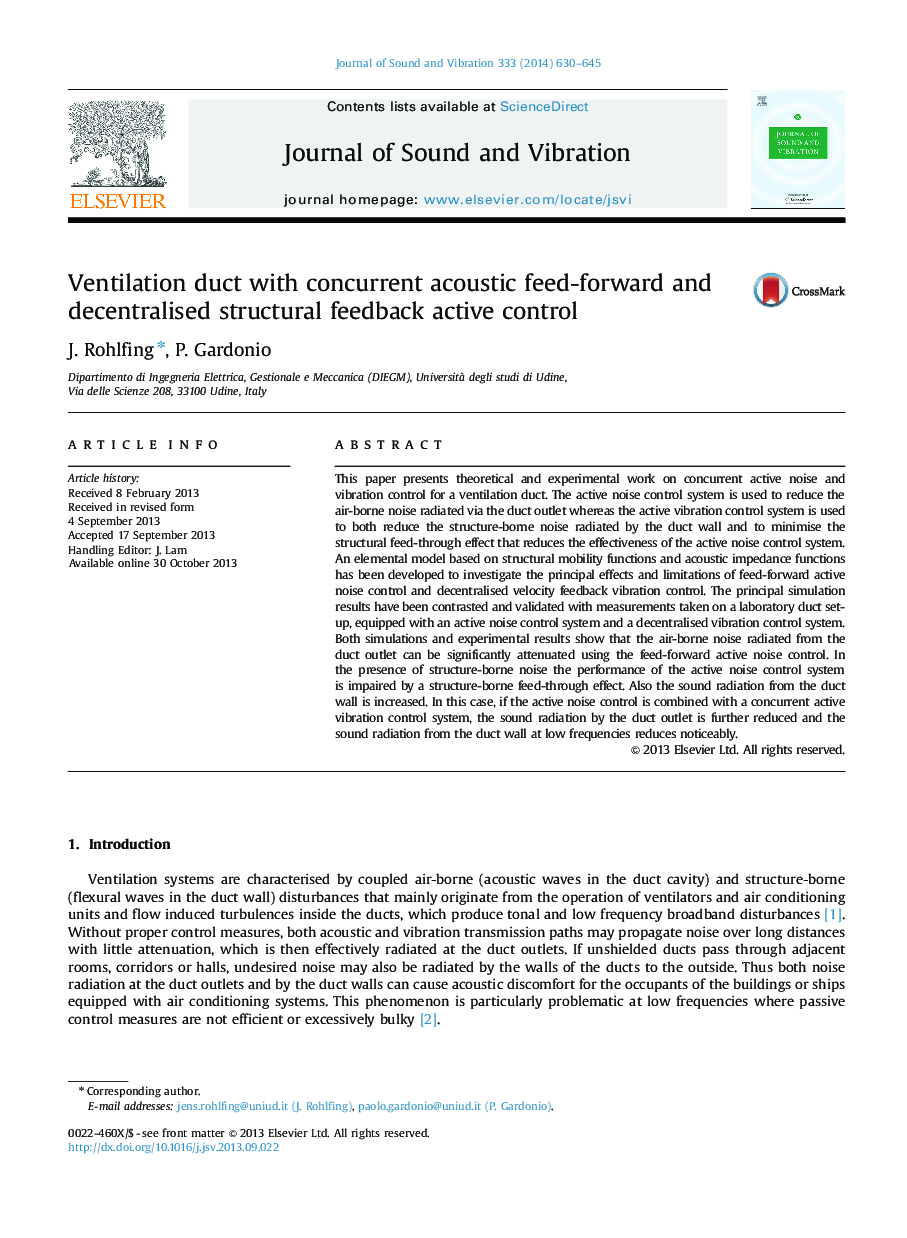| کد مقاله | کد نشریه | سال انتشار | مقاله انگلیسی | نسخه تمام متن |
|---|---|---|---|---|
| 10289319 | 509608 | 2014 | 16 صفحه PDF | دانلود رایگان |
عنوان انگلیسی مقاله ISI
Ventilation duct with concurrent acoustic feed-forward and decentralised structural feedback active control
ترجمه فارسی عنوان
مجرای تهویه با کنترل همزمان فعال بازخورد ساختاری و کنترل غیر مستقیم از طریق آکوستیک همزمان
دانلود مقاله + سفارش ترجمه
دانلود مقاله ISI انگلیسی
رایگان برای ایرانیان
ترجمه چکیده
این مقاله کارهای نظری و تجربی را در زمینه کنترل همزمان نویز و کنترل ارتعاش برای یک مجرای تهویه ارائه می دهد. سیستم کنترل نویز فعال برای کاهش سر و صدا هوا که از طریق خروجی کانال پخش می شود استفاده می شود در حالیکه سیستم کنترل ارتعاش فعال برای کاهش سر و صدا ساختار توسط تابش دیوار و کاهش اثر تغذیه ساختاری استفاده می شود کارایی سیستم کنترل نویز فعال را کاهش می دهد. یک مدل عنصری بر اساس توابع تحرک ساختاری و توابع امپدانس آکوستیکی برای بررسی اثرات اصلی و محدودیت های کنترل نویز فعال نویز خورده و کنترل لرزش بازده غیرمتمرکز توسعه داده شده است. نتایج شبیه سازی اصلی با اندازه گیری های انجام شده در یک مجرای آزمایشگاهی، مجهز به یک سیستم کنترل نویز فعال و یک سیستم کنترل ارتعاش غیر متمرکز، مقابله و اعتبار یافته است. هر دو شبیه سازی و نتایج تجربی نشان می دهد که سر و صدا هوا منتشر شده از خروجی کانال می تواند به طور قابل توجهی با استفاده از کنترل نویز فعال نویز خورده کاهش یابد. در حضور سر و صدا ساختار، عملکرد سیستم کنترل نویز فعال با اثر تغذیه از طریق ساختار کاهش می یابد. همچنین تابش صدا از دیوار مجرای افزایش می یابد. در این حالت، اگر کنترل نویز فعال با یک سیستم کنترل ارتعاش فعال همزمان ترکیب شده باشد، تابش صدا توسط خروجی کانال بیشتر کاهش می یابد و تابش صدا از دیوار کانال در فرکانس های پایین قابل ملاحظه ای کاهش می یابد.
موضوعات مرتبط
مهندسی و علوم پایه
سایر رشته های مهندسی
مهندسی عمران و سازه
چکیده انگلیسی
This paper presents theoretical and experimental work on concurrent active noise and vibration control for a ventilation duct. The active noise control system is used to reduce the air-borne noise radiated via the duct outlet whereas the active vibration control system is used to both reduce the structure-borne noise radiated by the duct wall and to minimise the structural feed-through effect that reduces the effectiveness of the active noise control system. An elemental model based on structural mobility functions and acoustic impedance functions has been developed to investigate the principal effects and limitations of feed-forward active noise control and decentralised velocity feedback vibration control. The principal simulation results have been contrasted and validated with measurements taken on a laboratory duct set-up, equipped with an active noise control system and a decentralised vibration control system. Both simulations and experimental results show that the air-borne noise radiated from the duct outlet can be significantly attenuated using the feed-forward active noise control. In the presence of structure-borne noise the performance of the active noise control system is impaired by a structure-borne feed-through effect. Also the sound radiation from the duct wall is increased. In this case, if the active noise control is combined with a concurrent active vibration control system, the sound radiation by the duct outlet is further reduced and the sound radiation from the duct wall at low frequencies reduces noticeably.
ناشر
Database: Elsevier - ScienceDirect (ساینس دایرکت)
Journal: Journal of Sound and Vibration - Volume 333, Issue 3, 3 February 2014, Pages 630-645
Journal: Journal of Sound and Vibration - Volume 333, Issue 3, 3 February 2014, Pages 630-645
نویسندگان
J. Rohlfing, P. Gardonio,
